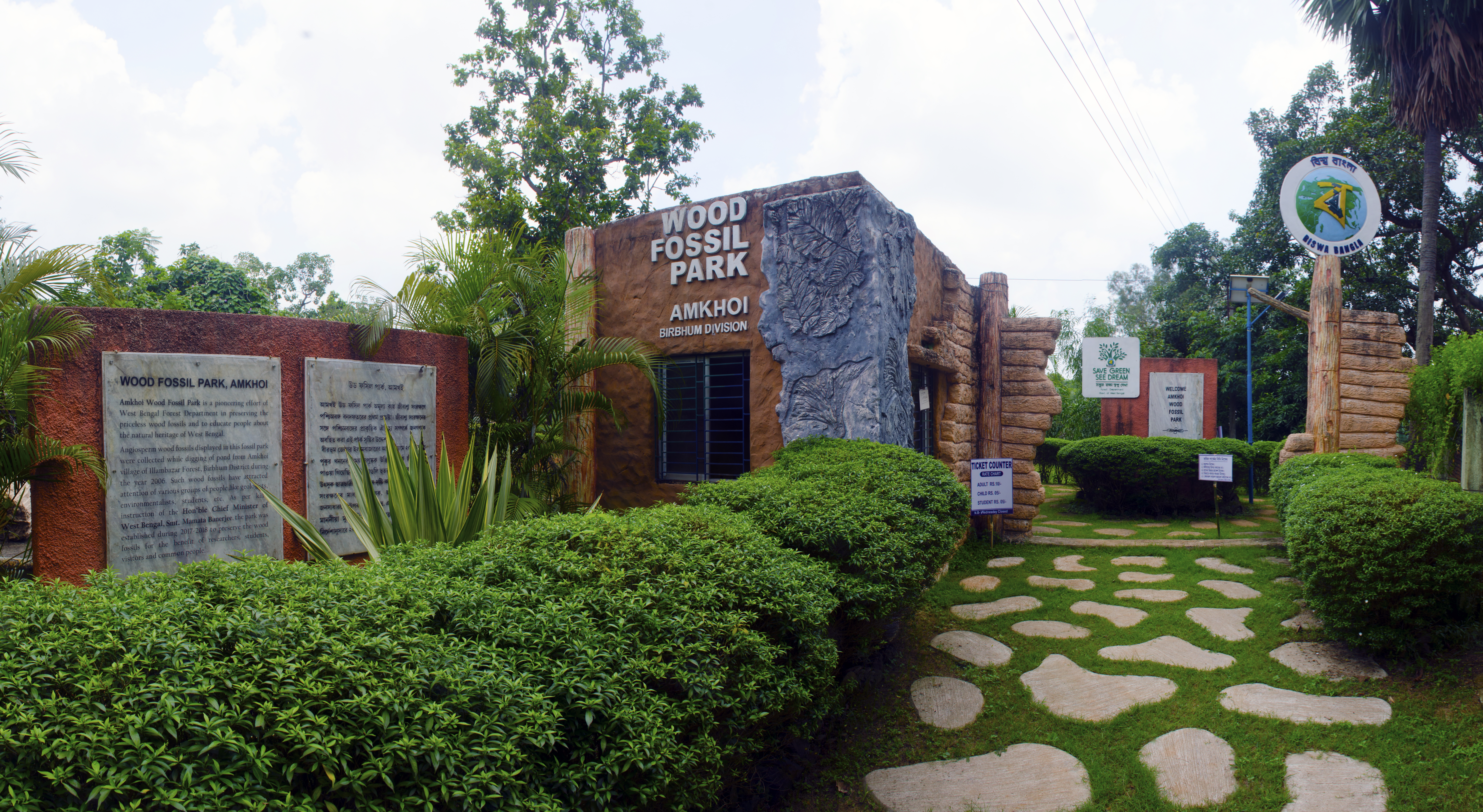|
Amkhoi Fossil Park
Amkhoi Fossil Park is a fossil park located near Illambazar in the Birbhum District of West Bengal, India. It contains fossilized wood 15 to 20 million years of age and is officially recognized by the State Forest Department of West Bengal. In 2016 while digging a pond the villagers of Amkhoi village, near Ilambazar, found some large bone-like structures. Later it was established that the bone-like structures were actually wood fossils. Fossilized or petrified wood is often considered as semi-precious ‘stones’ and often used in jewellery — fetching a good market value. As the word spread it attracted fossil hunters from far and wide. To prevent the vandalism and theft of fossils the forest department decided to convert the area into a fossil park. In 2017 - 18 the park came into existence and was called Amkhoi Wood Fossil Park. The aim of the park was to create awareness about fossils among students and common people, and also try to help scholars in their research. It is t ... [...More Info...] [...Related Items...] OR: [Wikipedia] [Google] [Baidu] |
Birbhum
Birbhum district () is an administrative unit in the Indian state of West Bengal. It is the northernmost district of Burdwan division—one of the five administrative divisions of West Bengal. The district headquarters is in Suri. Other important cities are Bolpur, Rampurhat and Sainthia. Jamtara, Dumka and Pakur districts of the state of Jharkhand lie at the western border of this district; the border in other directions is covered by the districts of Bardhaman and Murshidabad of West Bengal. Often called "the land of red soil",Rahim, Kazi MB, and Sarkar, Debasish, ''Agriculture, Technology, Products and Markets of Birbhum District'', ''Paschim Banga'', Birbhum Special Issue, pp. 157–166, Information and Cultural Department, Government of West Bengal. Birbhum is noted for its topography and its cultural heritage which is somewhat different from the other districts in West Bengal. The western part of Birbhum is a bushy region, a part of the Chota Nagpur Plateau. This region ... [...More Info...] [...Related Items...] OR: [Wikipedia] [Google] [Baidu] |
West Bengal
West Bengal (, Bengali: ''Poshchim Bongo'', , abbr. WB) is a state in the eastern portion of India. It is situated along the Bay of Bengal, along with a population of over 91 million inhabitants within an area of . West Bengal is the fourth-most populous and thirteenth-largest state by area in India, as well as the eighth-most populous country subdivision of the world. As a part of the Bengal region of the Indian subcontinent, it borders Bangladesh in the east, and Nepal and Bhutan in the north. It also borders the Indian states of Odisha, Jharkhand, Bihar, Sikkim and Assam. The state capital is Kolkata, the third-largest metropolis, and seventh largest city by population in India. West Bengal includes the Darjeeling Himalayan hill region, the Ganges delta, the Rarh region, the coastal Sundarbans and the Bay of Bengal. The state's main ethnic group are the Bengalis, with the Bengali Hindus forming the demographic majority. The area's early history featured a succession ... [...More Info...] [...Related Items...] OR: [Wikipedia] [Google] [Baidu] |
Ilambazar
Ilambazar is a census town, with a police station, in Ilambazar CD block in Bolpur subdivision of Birbhum district in the Indian state of West Bengal. A traditional weaving and trading centre it serves as a gateway to Birbhum district. History Ilambazar developed as a trade centre because of its location at the junction of thoroughfares and the river front. It also had the advantage of being near weaving centres. The British East India Company had a factory at Ilambazar. The French East India Company also made a foray in the Ilambazar area in the 1780s, which drove prices up to the benefit of the weavers. The English assumed direct administration of Birbhum district in 1786. Birbhum was badly impacted by the Great Bengal famine of 1770. Many villages were wiped out entirely, and even in large towns, over three quarters of households perished. During a peasants' insurrection in June 1789, Ilambazar was sacked, although it recovered and became a magnet for manufacturing and trade. ... [...More Info...] [...Related Items...] OR: [Wikipedia] [Google] [Baidu] |
Angiosperm
Flowering plants are plants that bear flowers and fruits, and form the clade Angiospermae (), commonly called angiosperms. The term "angiosperm" is derived from the Greek words ('container, vessel') and ('seed'), and refers to those plants that produce their seeds enclosed within a fruit. They are by far the most diverse group of land plants with 64 orders, 416 families, approximately 13,000 known genera and 300,000 known species. Angiosperms were formerly called Magnoliophyta (). Like gymnosperms, angiosperms are seed-producing plants. They are distinguished from gymnosperms by characteristics including flowers, endosperm within their seeds, and the production of fruits that contain the seeds. The ancestors of flowering plants diverged from the common ancestor of all living gymnosperms before the end of the Carboniferous, over 300 million years ago. The closest fossil relatives of flowering plants are uncertain and contentious. The earliest angiosperm fossils are in the ... [...More Info...] [...Related Items...] OR: [Wikipedia] [Google] [Baidu] |
Dipterocarpaceae
Dipterocarpaceae is a family of 16 genera and about 695 known species of mainly tropical lowland rainforest trees. The family name, from the type genus ''Dipterocarpus'', is derived from Greek (''di'' = two, ''pteron'' = wing and ''karpos'' = fruit) and refers to the two-winged fruit. The largest genera are ''Shorea'' (196 species), ''Hopea'' (104 species), ''Dipterocarpus'' (70 species), and ''Vatica'' (65 species).Ashton, P.S. Dipterocarpaceae. In ''Tree Flora of Sabah and Sarawak,'' Volume 5, 2004. Soepadmo, E., Saw, L. G. and Chung, R. C. K. eds. Government of Malaysia, Kuala Lumpur, Malaysia. Many are large forest-emergent species, typically reaching heights of 40–70 m, some even over 80 m (in the genera ''Dryobalanops'', ''Hopea'' and ''Shorea''), with the tallest known living specimen (''Shorea faguetiana'') 93.0 m tall. The species of this family are of major importance in the timber trade. Their distribution is pantropical, from northern South America to Africa, the Se ... [...More Info...] [...Related Items...] OR: [Wikipedia] [Google] [Baidu] |
Anacardiaceae
The Anacardiaceae, commonly known as the cashew family or sumac family, are a family of flowering plants, including about 83 genera with about 860 known species. Members of the Anacardiaceae bear fruits that are drupes and in some cases produce urushiol, an irritant. The Anacardiaceae include numerous genera, several of which are economically important, notably cashew (in the type genus ''Anacardium''), mango, Chinese lacquer tree, yellow mombin, Peruvian pepper, poison ivy, poison oak, sumac, smoke tree, marula and cuachalalate. The genus ''Pistacia'' (which includes the pistachio and mastic tree) is now included, but was previously placed in its own family, the Pistaciaceae. Description Trees or shrubs, each has inconspicuous flowers and resinous or milky sap that may be highly poisonous, as in black poisonwood and sometimes foul-smelling. Natural System of Botany (1831)pages 125-127/ref> Resin canals located in the inner fibrous bark of the fibrovascular syst ... [...More Info...] [...Related Items...] OR: [Wikipedia] [Google] [Baidu] |
Leguminosae
The Fabaceae or Leguminosae,International Code of Nomenclature for algae, fungi, and plants. Article 18.5 states: "The following names, of long usage, are treated as validly published: ....Leguminosae (nom. alt.: Fabaceae; type: Faba Mill. Vicia L.; ... When the Papilionaceae are regarded as a family distinct from the remainder of the Leguminosae, the name Papilionaceae is conserved against Leguminosae." English pronunciations are as follows: , and . commonly known as the legume, pea, or bean family, are a large and agriculturally important of |
Shantiniketan
Santiniketan is a neighbourhood of Bolpur town in the Bolpur subdivision of Birbhum district in West Bengal, India, approximately 152 km north of Kolkata. It was established by Maharshi Devendranath Tagore, and later expanded by his son, Rabindranath Tagore whose vision became what is now a university town with the creation of Visva-Bharati.Pearson, WW.: ''Santiniketan Bolpur School of Rabindranath Tagore'', illustrations by Mukul Dey, The Macmillan Company, 1916 History In 1863, Debendranath Tagore took on permanent lease of land, with two ( Alstonia scholaris) trees, at an annual payment of Rs. 5, from Bhuban Mohan Sinha, the talukdar of Raipur, Birbhum. He built a guest house there and named it ''Shantiniketan'' (the abode of peace). Gradually, the whole area came to be known as Shantiniketan.Basak, Tapan Kumar, ''Rabindranath-Santiniketan-Sriniketan (An Introduction)'', p. 2, B.B.Publication Binoy Ghosh says that Bolpur was a small place in the middle of the 19th ... [...More Info...] [...Related Items...] OR: [Wikipedia] [Google] [Baidu] |


_langs_de_weg_bij_Ragas_aan_de_baai_van_Banten_TMnr_10012892.jpg)

